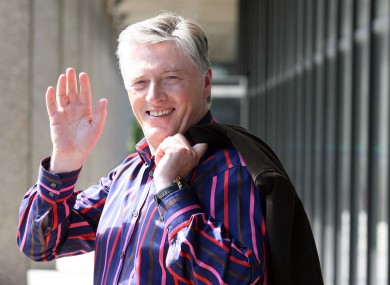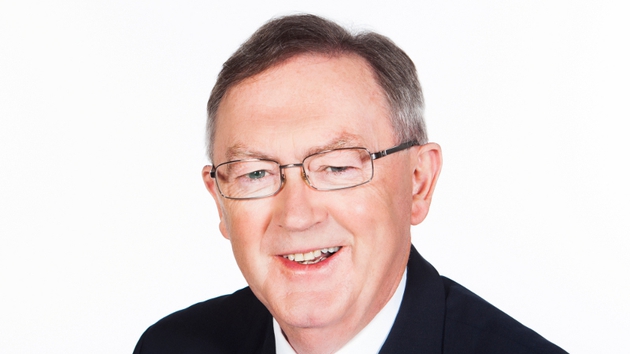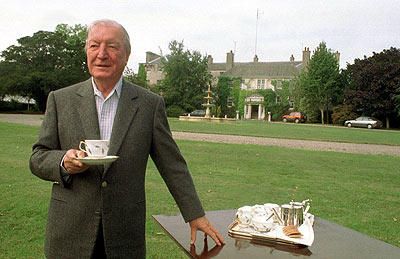Serious respiratory infection illness made Charlie Haughey look for his place in Irish history
Charles Haughey: The US ambassador complimented the “measured statesmanlike tones” of Haughey during his ard-fheis speech in February1989, which she said were “in strong contrast to the stridently partisan speech of Fine Gael leader Alan Dukes at his party conference”.
A bout of serious illness led to a dramatic change in Charles Haughey’s leadership style as Taoiseach, making him realise it was his “last chance to make his place in Irish history”, US ambassador Margaret Heckler told secretary of state James Baker in a confidential cable in March 1989.
She said the illness made Haughey “determined to rise above his hitherto dominant image as the ultimate political boss”.
In ‘firm control’
A few days later another cable sent in advance of Haughey’s St Patrick’s Day visit to the US described him as being in “firm control” of Irish politics.
In ‘firm control’
A few days later another cable sent in advance of Haughey’s St Patrick’s Day visit to the US described him as being in “firm control” of Irish politics.
“The only cloud on Haughey’s horizon is his health. He has not recovered fully from a severe respiratory infection last fall and will consult a specialist during his Washington trip.”
Haughey had spent time in the intensive care unit of the Mater hospital in October 1988 and the Cork Examinerreported that his heart had stopped but this was vehemently denied by a government spokesman.
The cables were obtained under the US freedom ofinformation Act on foot of a request to the state department for any records from 1989 relating to Charles Haughey. Some records were refused for US national security/foreign policy reasons.
Many of the cables from 1989 deal with the fallout from Haughey’s disastrous decision to call a surprise general election in June which resulted in Fianna Fáil losing seats.
To retain power he formed a coalition with the Progressive Democrats, the first time Fianna Fáil ever participated in a coalition government.
Great survivor
Heckler wrote on July 15th, the day the coalition was formed: “In the end, it would seem, after all, that Haughey, the great survivor of Irish politics, has once againfashioned a victory from defeat . . . In entering a coalition he has put national interests above sectarian party concerns.”
Great survivor
Heckler wrote on July 15th, the day the coalition was formed: “In the end, it would seem, after all, that Haughey, the great survivor of Irish politics, has once againfashioned a victory from defeat . . . In entering a coalition he has put national interests above sectarian party concerns.”
In the cables, Heckler complimented the “measured statesmanlike tones” of Haughey during his ardfheis speech in February1989, which she said were “in strong contrast to the stridently partisan speech of Fine Gael leader Alan Dukes at his party conference”.
HSE managers warned of risks to patients from funding cuts and under staffing
CONFIDENTIAL ‘RISK REGISTER’ SHOWS SCALE OF CHALLENGES FACING HEALTH SERVICE


Under pressure from the troika over health costs, the HSE budget has been cut by more than 20 per cent, or €3 billion, since the financial crisis began in 2008.
Health Service Executive managers have warned of high risks to patient safetyas a result of under staffing and spending cuts across key areas of the health service, internal records show.
The executive’s confidential “corporate risk register” provides an insight into the most urgent challenges facing the organisation as it tries to cope with fewer employees and increased demand for services.
The register, seen by The Irish Times, shows the greatest risks facing the executive over the past year. They include:
Harm to patients arising from inadequate delivery of vital health services linked to understaffing;
Funding running out for the nursing home support scheme, causing knock-on problems across the health services;
Unsafe services for children due to a failure to comply with childcare regulations and standards; and
Risk of vaccine-preventable disease, such as measles, occurring due to failure to achieve targets for vaccine uptake.
The troika
Under pressure from the troika over health costs, the HSE budget has been cut by more than 20 per cent, or €3 billion, since the financial crisis began in 2008.
Under pressure from the troika over health costs, the HSE budget has been cut by more than 20 per cent, or €3 billion, since the financial crisis began in 2008.
It has also lost more than 11,000 employees over the same period. This year the HSE faces another steep budget cut, although its service plan pledges to deliver the “maximum level of safe services possible”.
However, a detailed breakdown of risks facing individual services across the HSE shows elevated concern over the safety of cancer care for thousands of patients.
Highest risk
One of the highest risk ratings is linked to not having sufficient staff that are “essential to ensure adherence to quality control and quality assurance strategies” across cancer services.
One of the highest risk ratings is linked to not having sufficient staff that are “essential to ensure adherence to quality control and quality assurance strategies” across cancer services.
There is also concern that designated cancer centres may fail to meet basic standards or targets for speedy delivery of care due to “fiscal challenges, the recruitment moratorium and other priorities”.
The HSE was not in a position to comment on the register last night, but the documents show it has drafted action plans for all risks identified.
For example, in areas such as patient safety, the register states there is a stronger focus on clinical care through the appointment of clinical directors, healthcare audits andtraining.
The risk register – a common tool across large firms – measures the greatest threats facing an organisation and ranks them in terms of impact and likelihood of occurring.
Fianna Fáil health spokesman Billy Kelleher has described warnings of high risks to patients as a result of understaffing and spending cuts as “frightening but not surprising”.
He said the revelations confirm what his party has been saying “about the high risk to public safety arising from Minister James Reilly’s handling of the health service”.
“[IT] is a damning indictment of Government policy and will cause huge amounts of anxiety amongst patients and their families,” he said.
The TD for Cork north-central called on the Health Minister to “urgently” clarify how these concerns are going to be addressed.
“This will impact on every family in Ireland,” he said. “Minster Reilly needs to urgently change his priorities and focus on frontline services to patients, which he has failed abysmally to do.”
Experienced Seán O’Rourke set to take over Pat Kenny’s slot


The veteran RTÉ news and current affairs broadcaster Seán O’Rourke is to be announced as successor to Pat Kenny’s morning radio show.
O’Rourke, who currently presents the RTÉ News at One programme and The Week in Politics on RTÉ television, will replace Kenny who announced his shock departure from the national broadcaster, where he has worked for over four decades, last week.
The move is set to create an intensive radio rivalry between two of the industry’s greatest luminaries in current affairs and whose shows will air at the same time.
A source revealed the decision was made at a meeting in a Monaghan hotel yesterday morning, and involved several key Montrose executives including director general Noel Curran and head of news and current affairs Kevin Bakhurst.
The announcement is due to be made on RTÉ Radio 1 on the Marian Finucane Show today where he will be interviewed by Aine Lawlor.
O’Rourke is renowned for his presence on the national broadcaster’s flagship radio news programme and has a reputation as a formidable interviewer, particularly of politicians.
His appointment will see him leave that slot for the first time in nearly two decades having started there in 1995.
The 54-year-old, from Portlaoise, began his career at the Connacht Tribune, following up with stints at the Sunday Press and Irish Press as a sports journalist, feature writer and political correspondent.
He has been with RTÉ news and current affairs since 1989 as an editor and presenter. He has also reported extensively from abroad.
It is unclear if, at all, the move will affect his other role as presenter of The Week in Politics which airs every Sunday night on RTÉ television.
Kenny made the surprise announcement last week in what was widely considered an industry coup for Newstalk Radio, his new employer who said he would be on air from September 2nd next.
He said he was “relishing the challenge ahead and looking forward to a new chapter”, particularly in the world of independent broadcasting.
Last night, betting on Kenny’s replacement appeared to have been suspended on Paddy PowerKenny worked with the State broadcaster for the last 41 years before joining the Denis O’Brien controlled Newstalk where he will anchor the station’s prime time slot.
Thousands of AIB customers subject to loan credit errors
Thousands of AIB customers may have been turned down for loans because the bank sent incorrect customer data to the Irish Credit Bureau, according to reports.
The Irish Independent today reports that as many as 12,000 customers may have been incorrectly identified as having poor track records for repaying loans.
It’s believed the errors occurred over a period of six years.
Last year thousands of AIB customers learned that incorrect records were kept on their loan histories, as overdue loans were marked down as being a 4 weeks late, when in fact they may have been only overdue a week.
Harvard School study says breakfast every day can keep the doctor away


The well known benefits of eating a good breakfast are endless, from its metabolism-boosting powers to staving off mid-morning hunger pangs.
But recent research added a new factor to the mix, when it was found that men who regularly skipped breakfast had a 27% higher risk of heart attack or death from coronary heart disease than those who routinely ate a morning meal.
The study, by Harvard School of Public Health (HSPH) in the USA, is the first of its kind to indicate a direct link between the two, and found that breakfast-skippers were generally hungrier later in the day and ate more food at night, perhaps leading to metabolic changes and heart disease.
It followed 26,902 men aged 45-82 over a 16-year period and even after accounting for diet, physical activity, smoking and other lifestyle factors, the association between skipping breakfast and heart disease persisted.
Lead author Dr Leah Cahill, a research fellow at HSPH, suggests: “Skipping breakfast may lead to one or more risk factors, including obesity, high blood pressure, high cholesterol and diabetes, which may in turn lead to a heart attack over time.”
Cahill says the research team expects the results to apply to women as well, and they currently have a similar study with females under way.
Daniel McCartney, a lecturer in dietetics at DIT says: “Breakfast kick-starts the metabolism and wakes up the body.
“A high-fibre cereal will also slow absorption of sugar from the gut. Insoluble fibre — found in cereals such as Weetabix and All Bran and in bananas — can fill you until lunch time.
Dietitian Victoria Taylor suggests wholegrain toast or cereals like porridge with low-fat milk are a good way to start the day.
“Try a sliced banana or dried fruit on top and you’ll be on your way to five-a-day before you’ve even left the house,” she adds.
“A healthy and filling breakfast can make that mid-morning biscuit less tempting, as well as giving you another opportunity to widen the variety of foods in your diet.”
Healthy options include the following: nPorridge made with semi-skimmed milk topped with a selection of dried fruits. Oats are a good source of insoluble fibre.
* Muesli, fresh fruit and low-fat yoghurt. Added fruit counts towards your five-a-day, and low-fat yoghurt provides calcium and protein.
* Wholegrain breakfast cereal with semi-skimmed milk. Many cereals are fortified with vitamins and minerals.
* Boiled egg with wholemeal toast and low-fat spread. Eggs are a good source of protein, minerals and vitamins A, D and B2. Wholemeal bread contains B vitamins, vitamin E, fibre and a range of minerals.
Perseid meteor shower will help astronomers get a better view of space


As sky-watchers marvel at the beauty of the annual Perseid meteor shower — set to peak late Sunday and early Monday — astronomers will be thanking their shooting stars for another reason. Airborne pollution from vaporized meteors is proving crucial for the nextgeneration of super-sharp snapshots of exotic moons and distant galaxies.
Pollution of any kind is usually bad NEWS for telescopes, which thrive on clear skies. But shooting stars — flaming bits of debris from comets — leave behind traces of an element astronomers are harnessing to sharpen the focus of their telescopes.
That element is sodium. Traces of it waft in a band encircling the Earth about 55 miles above ground. American astronomer Vesto Slipher of Arizona discovered this sodium layer in 1929, but only recently have astronomers found a use for it — by zapping it with lasers.
“We can excite the sodium [with a laser] and make an artificial star,” said Chad Trujillo of the Gemini Observatory, a multinational consortium that operates telescopes in Hawaii and Chile.
Sensors watching these artificial “guide stars” see them twinkle — the effect of atmospheric turbulence. This wavy air usually renders distant targets fuzzy. But by watching the guide star, sophisticated computers on the ground can calculate the turbulence and send that data to the telescope. Sophisticated mirrors in the telescope then deform hundreds of times per second to compensate for the wavy air.
It’s like adding a pair of glasses with rapidly changing prescriptions to the telescope.
This technique — adaptive optics — has been called the biggest advance in ground-based astronomy since Galileo’s first telescope some 400 years ago. “You get better resolution from the ground than you can from space,” Trujillo said.
Astronomers began to tinker with crude adaptive optics in the 1950s. But the technology did not mature until the military became interested in artificial guide stars in the 1980s, said Claire Max, director of the center for adaptive optics at the University of California Observatories. “At that point, it was all highly classified,” said Max, who was working at the Lawrence Livermore National Laboratory at the time. The military wanted to image Soviet satellites, but Max had other ideas: “I said, ‘Astronomical objects move a lot slower that satellites, so I think it will be a great idea for astronomy.’ ”
Max and her colleagues pushed the Defense Department to declassify the technology, which it did in the early 1990s. “There was a famous meeting of the American Astronomical Society when the veil was lifted and everybody heard what the Air Force was doing,” Max said.
The first laser guide-star system came online at the Lick Observatory in 1995. Max used the system to bring Saturn’s moon Titan into focus. A hazy blob sharpened into view, allowing study of the storms raging in the moon’s methane atmosphere.
Earlier this year, the most sophisticated laser guide-star system to date came online at the Gemini South telescope in Chile. The $25 million system sharpens the telescope’s 25-foot mirror onto a wider swath of sky than ever before.
“We’re looking deep into the cores of colliding galaxies now and watching black holes. It’s really fun,” Max said. “You couldn’t see any of the detail if you looked without these systems.”
It took five years to build the Gemini guide-star system, but the experience will aid the next generation of giant telescopes. Laser guide stars will be crucial for maximizing their views.




No comments:
Post a Comment